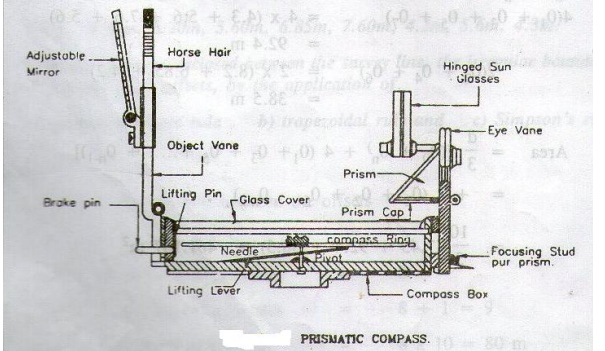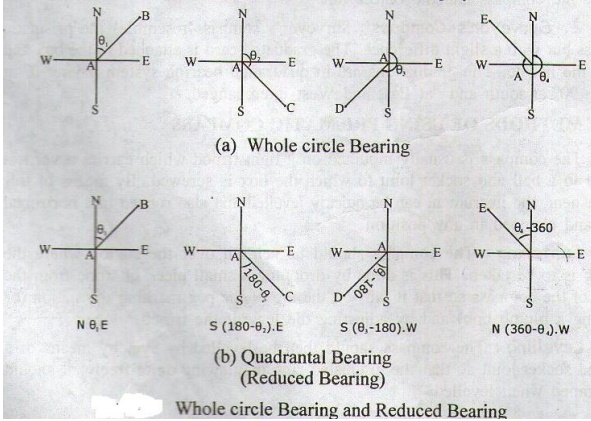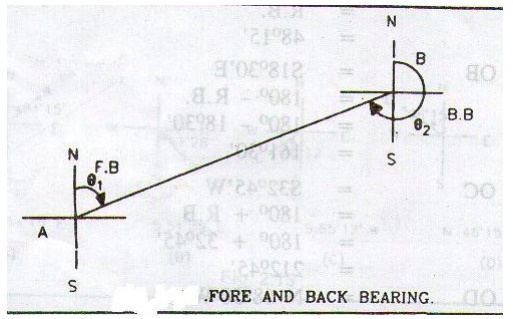Chapter: Civil Engineering : Surveying and Civil Engineering Materials
Compass survey
Compass survey
When the area to be surveyed is large, chain and compass surveying is preferable. A compass is used to measure the magnetic bearing of a line. There are two forms of compass that are commonly used. 1. The prismatic compass and 2. The surveyors’ compass.
1. The prismatic compass: It is
circular in shape and its diameter varies from 85 mm to 110 mm. A pivot
is provided at the centre of the box. It carries a magnetic needle. The needle
is attached to an aluminum ring which is graduated to 1/2. A light spring break
is attached to the inside of the base to damp the oscillations of the needle
and bring it to rest before taking a reading.
A reflecting prism facilitates
reading of the angles and is protected from moisture and dust etc by a prism
cap. The prism base and vertical facts are made convex which magnifies the
readings. the object vane is located diametrically opposite to the prism. It is
hinged to the side of the box and carries a horse hair. A title reflecting
mirror is provided on the side of the object vane to enable bearing of very
high or low objects to be taken. A metal cover is provided to enclose the
compass and the object vane.

2. Surveyor’s compass: Surveyor’s
compass resembles the prismatic compass but with a slight
difference. The graduated card is attached to the box and North 90 at south and
at East and West interchanged
1 Methods of using prismatic compass
The compass is usually mounted on
a light tripod which carries a vertical spindle in a ball and socket joint
which the box is screwed. By means of this arrangement, the instrument can be
quickly leveled and also rotated in a horizontal plane and clamped in any
position. Centering: The compass should be centered over the station
where the bearing is to be taken. This is done by dropping a small piece
of stone from the centre of the compass so that it falls on the top of the peg
marking the station (or by using plumb bob) and by adjusting the legs of the
tripod.
Leveling : The
compass should then be leveled by eye, by means of a ball and socket joint so
that the graduated ring may swing quite freely. It should be clamped when
leveled. Observing Bearing: A ranging rod is kept at the next station.
The compass is turned until the
ranging rod at the station is bisected by the hair when looked through the slit
above the prism.
When the needle comes to rest, by
pressing the knob if necessary, the reading is noted at which the hair line
appears to out the image of the graduated ring. The sighting og the ranging rod
and the reading is done simultaneously. The reading gives the bearing of the
line.
2 bearing of line:
The bearing of a line is the
horizontal angle made by the line with a selected reference line called the
meridian. There are two types of bearings.
i) Magnetic Bearing: The
direction indicated by a freely supported magnetic needle unaffected by
local attractive forces, is called the magnetic meridian. The angle between any
line and magnetic meridian is called magnetic bearing or simply bearing.
ii)The Bearing: The line
joining6the
geographical north and south poles is known as the true meridian or
geographical meridian. The angle between any line and the true meridian is
called true bearing of azimuth.
3DESIGNATION OF BEARING
ü The whole
circle bearing system
ü Quadrantal
bearing system, or reduced bearing system

ü The whole circle bearing system:
In this system the bearing of a line is measured with north in
clockwise direction. The value of the bearing thus varies from 0o to 360o.
ü Quadrantal bearing system
In this system the bearing of a line measured from either the
north or the south, clockwise or counter clockwise whichever is nearer the
line, towards the east or west
4 Fore bearing and back bearing
In compass surveying, two
bearings are observed for each line, one from each end of the line. The bearing
of a line in the direction of the progress of survey is called fore bearing
while the bearing measured in the opposite direction is known as back bearing.
For e.g. the bearing of line AB taken from the point A is the fore bearing of
ine AB and the bearing from point B is back bearing of the line AB.

Related Topics